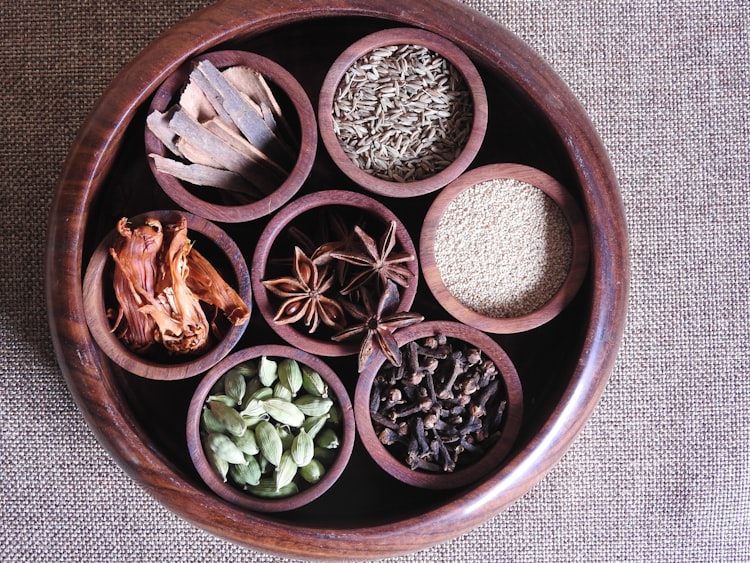Italian Gastronomy (Pt. 2 - Central Italy)
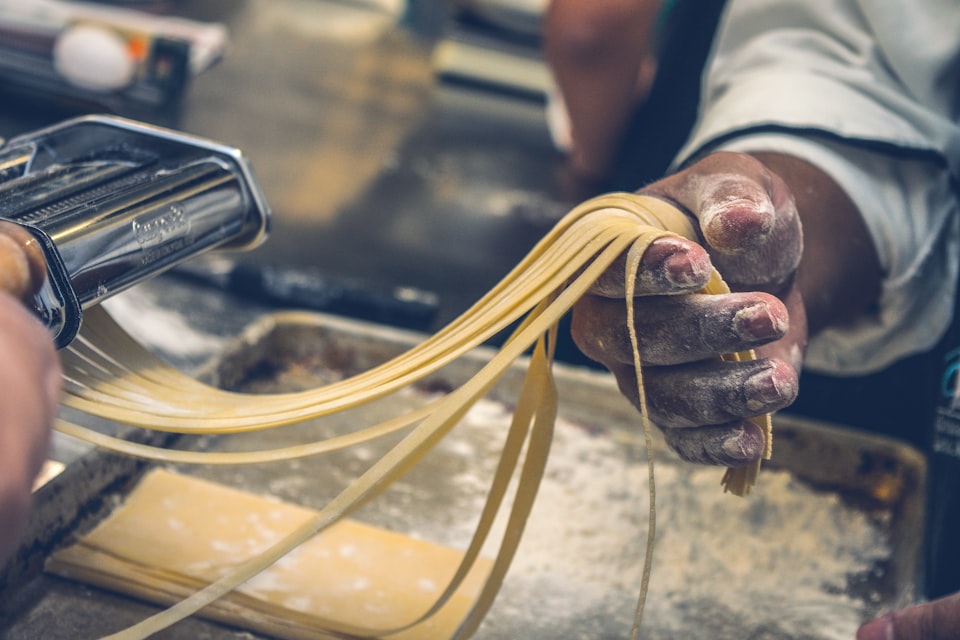
Italian food is consistently rated as the world's favorite cuisine. Pizza and pasta, Italy's two most famous international hits, also score as the world's favorite dishes. Who does these surveys and whether these facts translate into anything meaningful is unclear. What is clear is that Italian food is one of the most beloved and popular cuisines on this planet, and an understanding of Italian gastronomy should be on the top of every food lover's syllabus.
True Italian dishes are, for the most part, simple recipes that are made from high-quality, fresh ingredients that are in season. Food in Italy is intimately intertwined with the culture itself. Every country in the world has a certain ranking of priorities, and aspects of the culture reflect these priorities. Italy, like France, is one of the few countries that has an incredibly strong priority on food. Almost all cultures take deep pride in their own cuisine, but some people groups have developed an infatuation with the ingredients themselves. Where was the produce grown? What kind of breed, and from what region did this meat come? What processing and supply chain did this food have to go through to get to my plate? Is it the right season for these ingredients in order to serve this dish? These are the questions a chef asks, but are not the typical concerns the modern eater burdens themselves with when thinking about a simple meal from their own culture. Italy is one of the unique cultures that will prioritize food to such an extreme that these questions are subconsciously baked into the culture. This is one of the reasons that Italian food in Italy tastes so incredible. It is the prioritization of quality, fresh ingredients, as well as the genius that is pizza/pasta, that elevates Italian cuisine to the highest level of gastronomy.
History
Italy is usually discussed as Northern Italy vs. Southern Italy because the southern kingdoms had a relatively different political history than the northern kingdoms. Southern Italy historically had been under the control of Arabs, Greeks, Spanish, and Normans; on the other hand, Northern Italy has a past of French, Celts, and Germanic influences. Central Italy lies in between these two regional themes and benefits from a clash between the two. Central Italy is able to grab hold of elements of both the northern and southern cultures, settling into a cuisine which, although not as distinct as either extreme, results in absolutely incredible dishes!
The regions that define Central Italy are Lazio, Marche, Toscana (Tuscany), and Umbria. Lazio contains Rome and thus claims many of the most famous Italian pasta dishes: Cacio e Pepe, Carbonara, and Amatriciana. Marche had been a primarily vegetarian region, serving meat only on special occasions. Toscana (Tuscany) has an intense focus on simple, high-quality meat and seafood dishes. Umbria, the only region in Italy that is completely landlocked, specializes in pork products and mushrooms.
Regions
Lazio
Marche
Toscana (Tuscany)
Umbria
The ingredients ingrained into the Italian countryside are frequently featured in the entire country's cuisine: tomatoes, olive oil, oregano, and basil. Pasta and cheeses are of course a part of every Italian cook's pantry (or at least the eggs and Semolina / 00 flour), but each region emphasizes different types of pasta or cheese. Central Italy has a few of its own cheese and pasta specialities, namely Pecorino cheese (Pecorino Sardo, Pecorino Toscano and Pecorino Romano), Tagliatelle pasta (both Marche and Emilia-Romanga claim this pasta), Rigatoni pasta, and Tonnarelli pasta. In addition to the classics, there are a variety of produce options from Central Italy to emphasize the region's dishes, with artichokes standing out as a prominent staple. Finally, Central Italy boasts the best mushrooms in Italy, primarily due to the Umbria region, and features them prominently in the region's cuisine.
Major Ingredients
Tomato
Olive Oil
Oregano / Basil
Pasta
Cheese
Artichokes
Porcini / Truffles
Italian Meal Structure
Traditional
The Italian meal structure has been cultivated over centuries of culinary tradition. This master class in how to enjoy both food and company consists of 7-10 courses, each with a specific purpose.
- Aperitivo - Bubbly beverages and small appetizers (olives, nuts, and cheeses)
- Antipasto - Heavier appetizers (charcuterie and bread)
- Primo - Hot dish, usually without meat (pasta, gnocchi, risotto, etc.)
- Secondo - Meat or seafood entree
- Contorno - Vegetable side dish served along the Secondo
- Insalata (Optional) - Salad
- Formaggi e frutta (Optional) - Regional cheese and seasonal fruit
- Dolce - Dessert
- Caffè (Optional) - Espresso (without milk or sugar)
- Digestivo - Digestive alcoholic drink (limoncello, amaro, grappa, etc.)
Day-to-Day
Although an Italian menu might include most of the traditional meal structure, no Italian is going to eat an entire traditional meal on a daily basis. Instead, a more typical day in the life of an Italian might look like a pastry and cappuccino in the morning; followed up by a pizza, focaccia, or sometimes a primi dish for lunch; ending the day with a late dinner of primi or secondi, always with a glass of wine. Italians will finish dinner with a digistivo or coffee. However, the Italian rules on coffee are that if it is after dinner, or anytime further along in the day, it should be an espresso instead of one of the richer drinks you may consume in the morning like a cappuccino. It is poor form indeed to try to get a cappuccino after dinner.
Each Italian region does things a little differently, but these are the general eating patterns for the typical Italian. There are plenty more rules about "when to eat what" beyond the example coffee rule above, but I wouldn't stress about them. When learning about the cuisine, focus first on the food itself and not how to structure meals so that it is "culturally proper". Explore, and enjoy!
International Highlights
We start our highlight reel with the famous pasta dishes of Rome: Cacio e Pepe, Gricia, Carbonara, and Amatriciana. From there we highlight the popular pasta types from the central regions, as well as a decadent dish, Saltimbocca, and the incredibly popular Italian ice cream, Gelato. When taking a trip to any region in Central Italy, these are the minimum must-trys to say you've had a taste of the local cuisine.
Cacio e Pepe / Gricia / Carbonara / Amatriciana
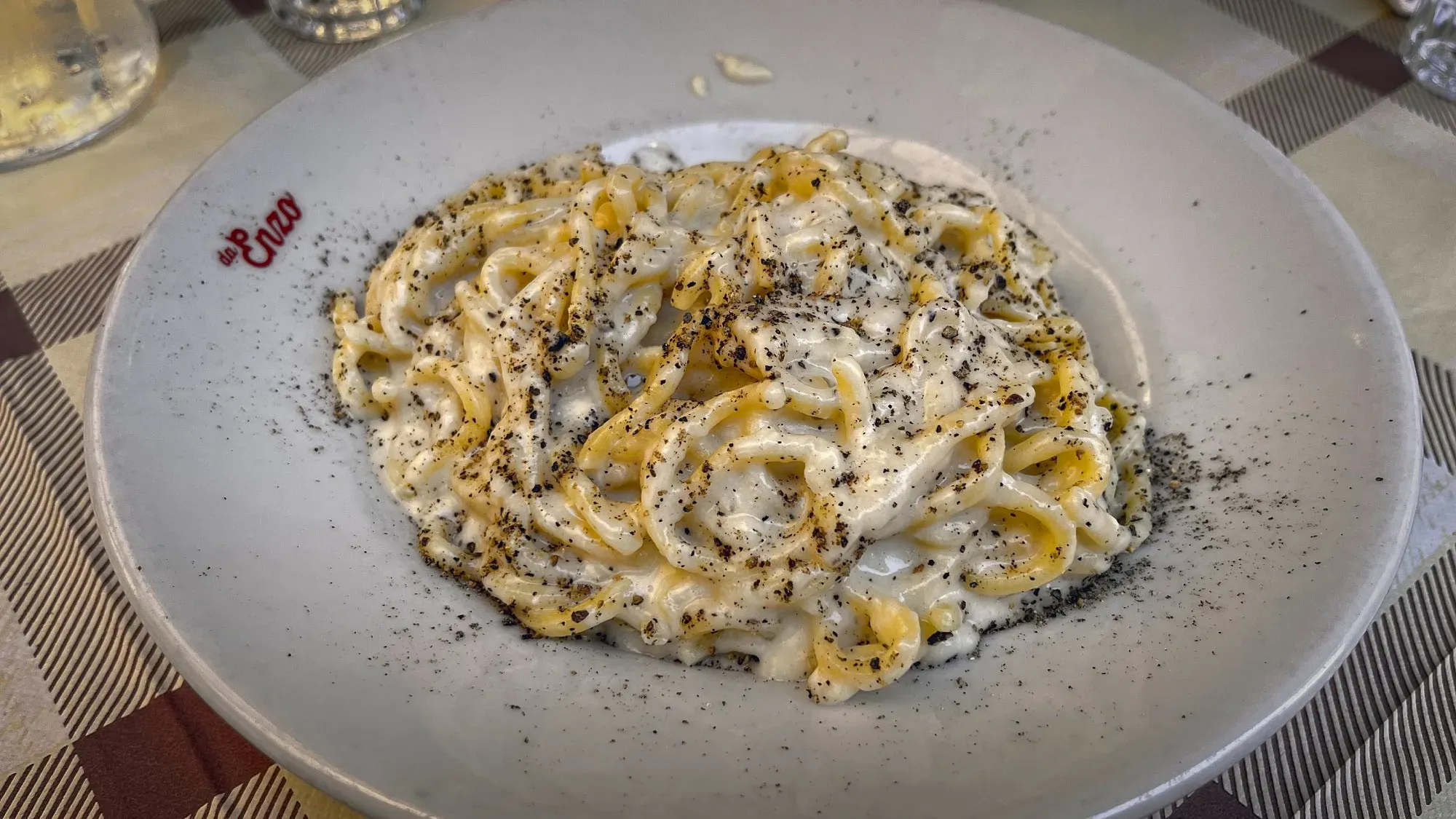
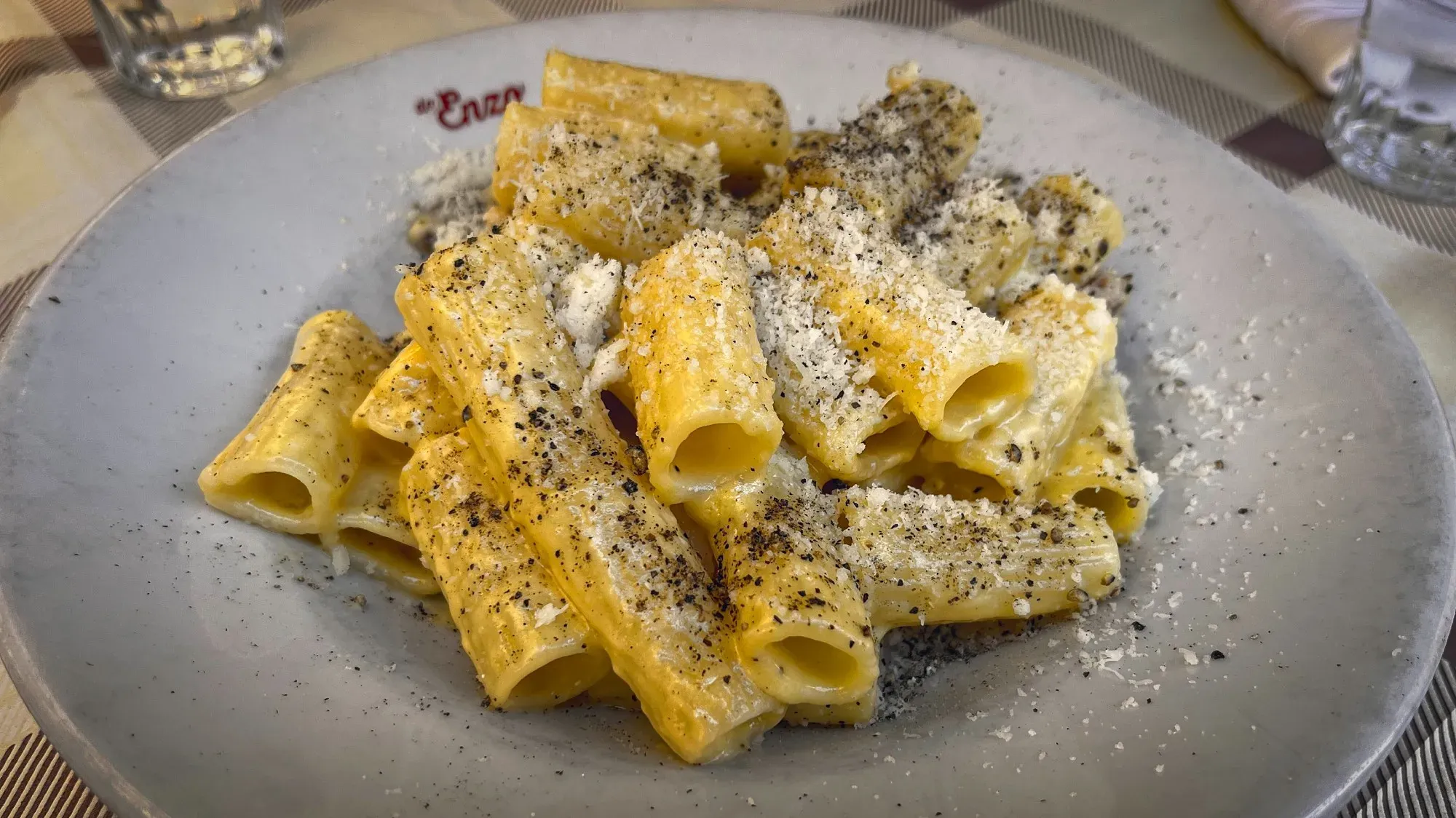
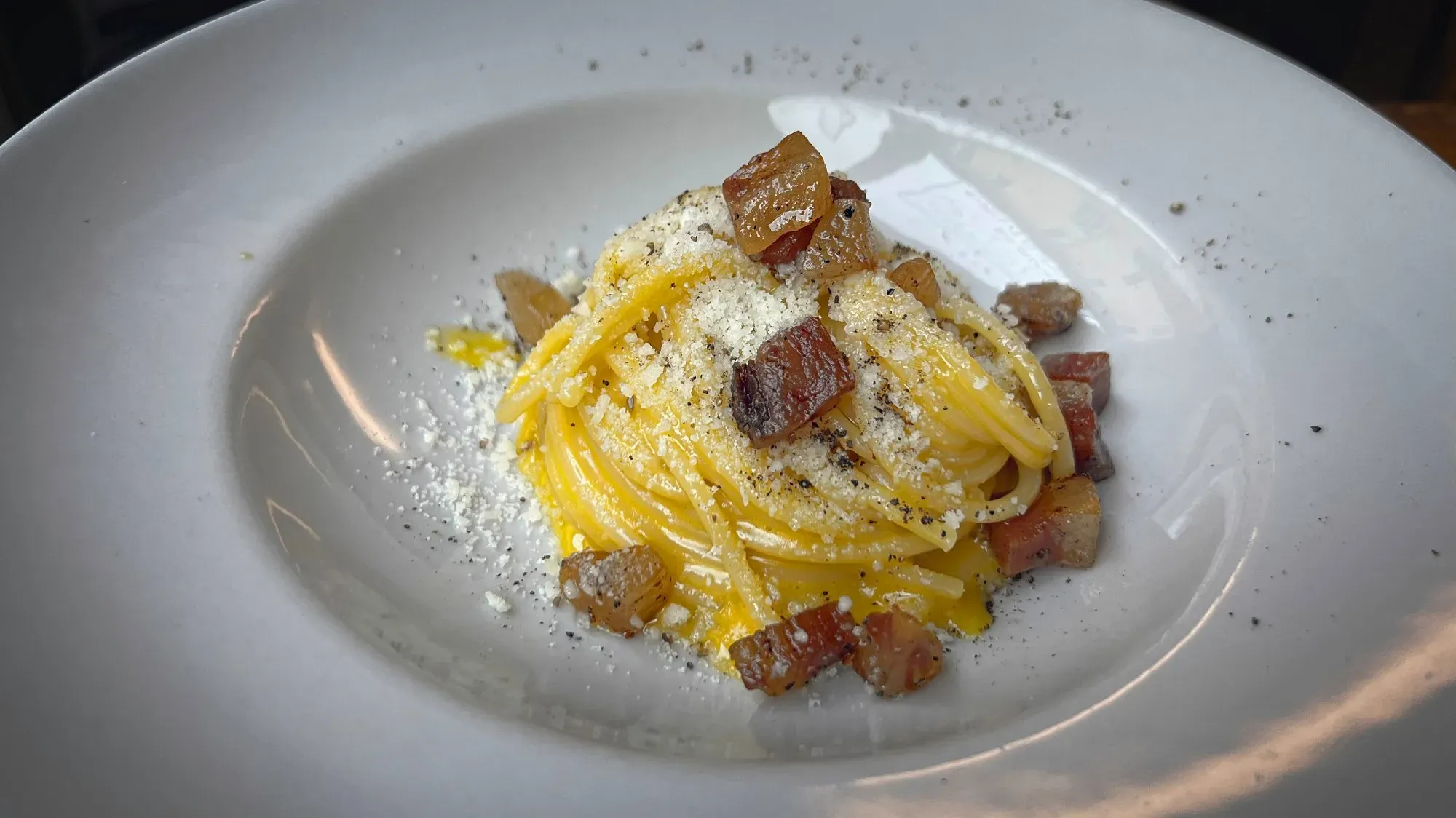
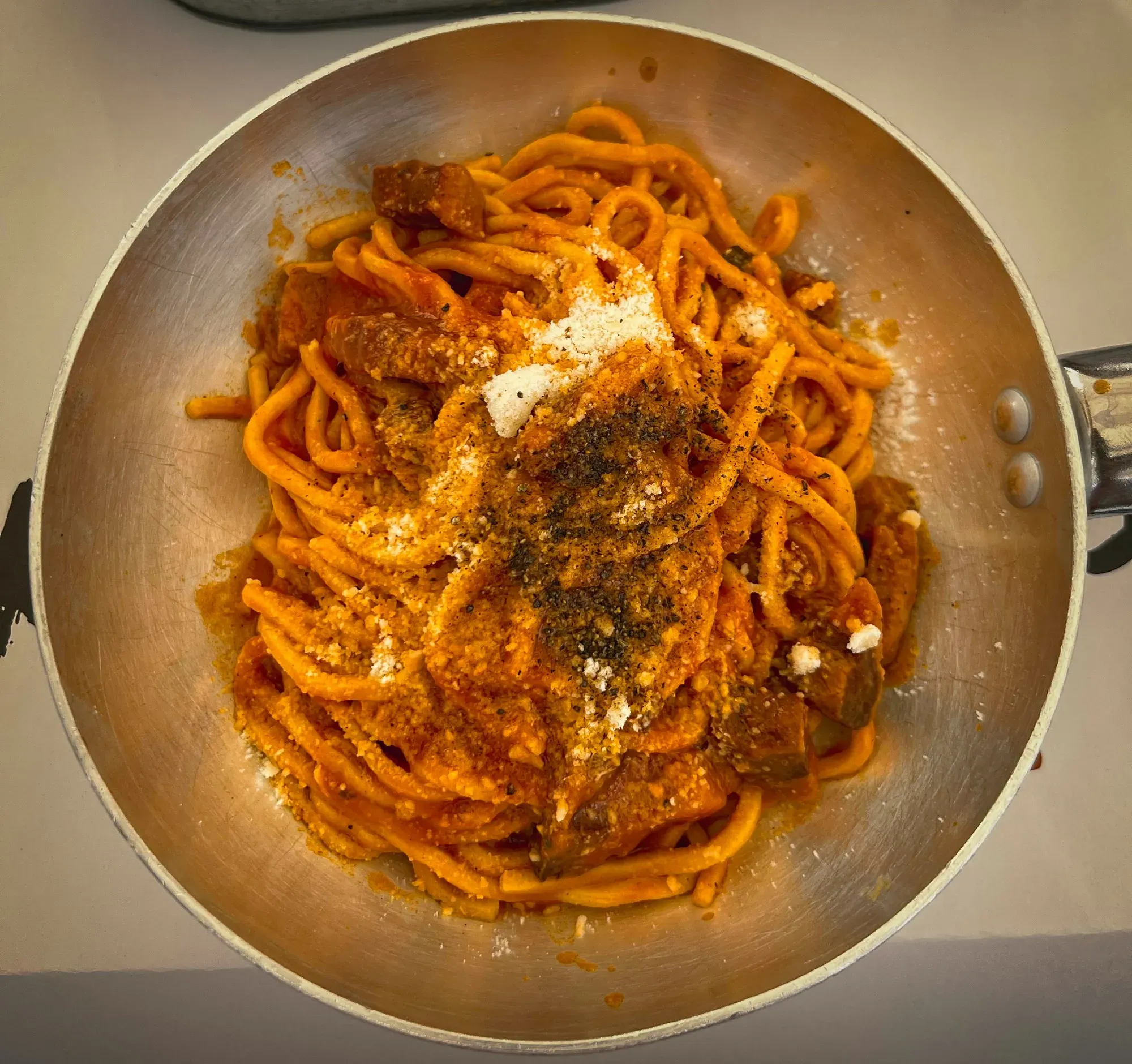
Many Italian pasta dishes have made it big on the international stage. A great deal of these dishes can be made with relatively simple recipes. The reason they shine is the skill of the chef and that chef's use of high-quality ingredients. Perhaps the best example of this is the Roman Four: four similar pasta dishes, popularized in Rome, that build off of one another with a single ingredient.
Cacio e Pepe is a pasta dish in which the sauce is created from an emulsion of pasta water, cheese, and black pepper. The classic cheese to use is Pecorino Romano but a combination of Pecorino and Parmigiano Reggiano is also perfectly acceptable.
Gricia builds off of Cacio e Pepe by adding Guanciale. Guanciale means "pork cheek" in Italian, and is packed with flavorful fat. Guanciale is the primary choice of meat in these dishes, but a substitute of pancetta, or even bacon if you are really desperate, is acceptable when guanciale is onerous to acquire.
Carbonara, probably the most popular of the Roman Four, does not need the pasta water for emulsion (although some can be used), and instead adds an egg to Gricia to make its signature yellow sauce. Similarly, Amatriciana uses a reduced tomato sauce to create a tomato-based version of the cheese, black pepper, and guanciale combo.
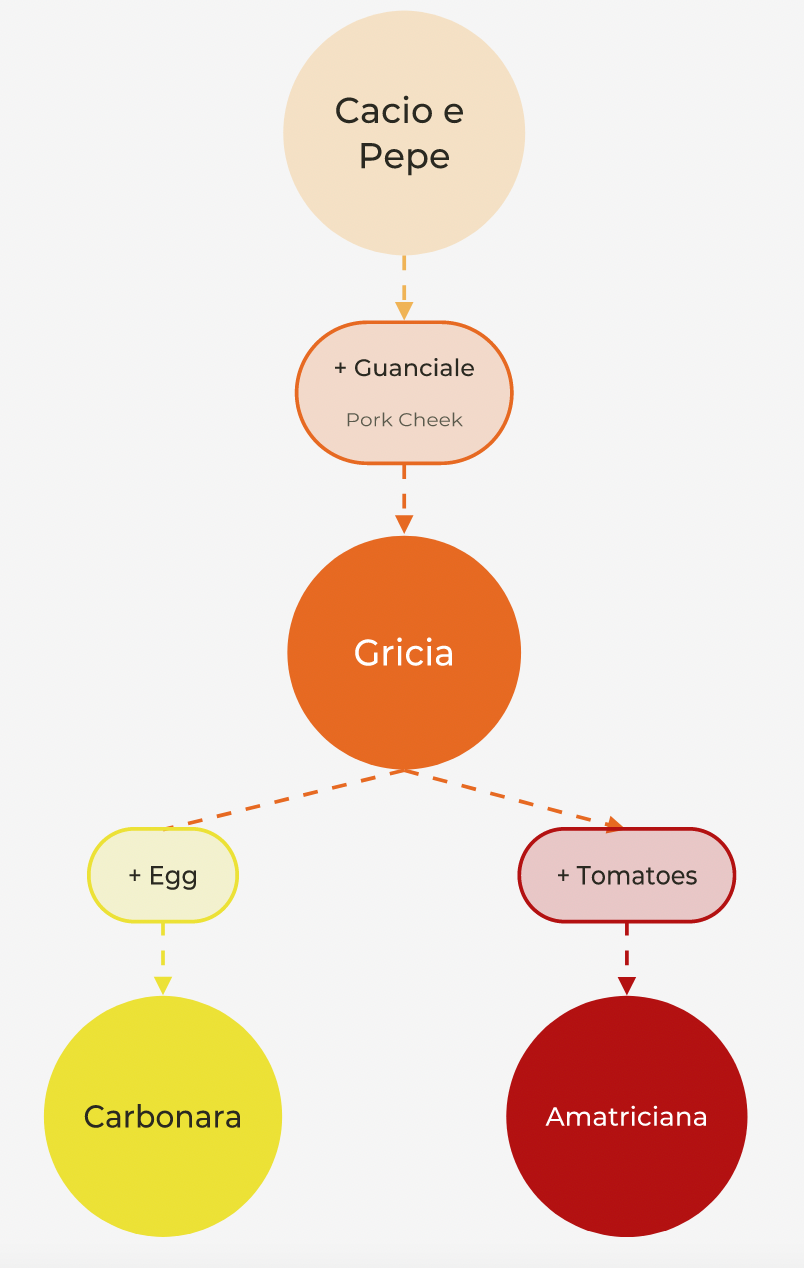
Practically any pasta can be used in conjunction with the Roman Four. Pay no heed to the fundamentalist; plenty of modern chefs have made incredible creations with atypical pasta types and slight twists to the classic recipes. However, for edification purposes you should know that these dishes are traditionally paired with: Spaghetti, Tonnarelli (similar to spaghetti), Rigatoni, and sometime Bucantini (for the Amatriciana).
Tonnarelli / Rigatoni / Tagliatelle
Practically every region in Italy can say they have invented a type of pasta or two. Tonnarelli is a pasta native to Rome, which is in essence a thicker Spaghetti. Rigatoni is a pasta that is now popular all over Italy, and while we are not sure, is likely to have originated from Rome. Tagliatelle is a thicker, flat-cut pasta. It is debated whether the Emilia-Romagna or the Marche region has the rightful claim to this pasta, but either way, it is popular in Central Italy and pairs great with mushrooms.
Saltimbocca
Saltimbocca, or Saltimbocca alla Romana, is a phenomenal dish of veal wrapped in prosciutto/sage and marinated in wine/oil/butter (depending on the region). "Alla Romana"indicates that this dish originated in Rome; however, many experts now think it might have been invented at the foothills of the alps. Although its true birthplace will likely remain a mystery, this dish certainly grew in fame from its Roman podium. While I am personally hesitant about the ethics of the dish, I hold back no such reservations in adoring the superb taste of this masterpiece.
Bruschetta
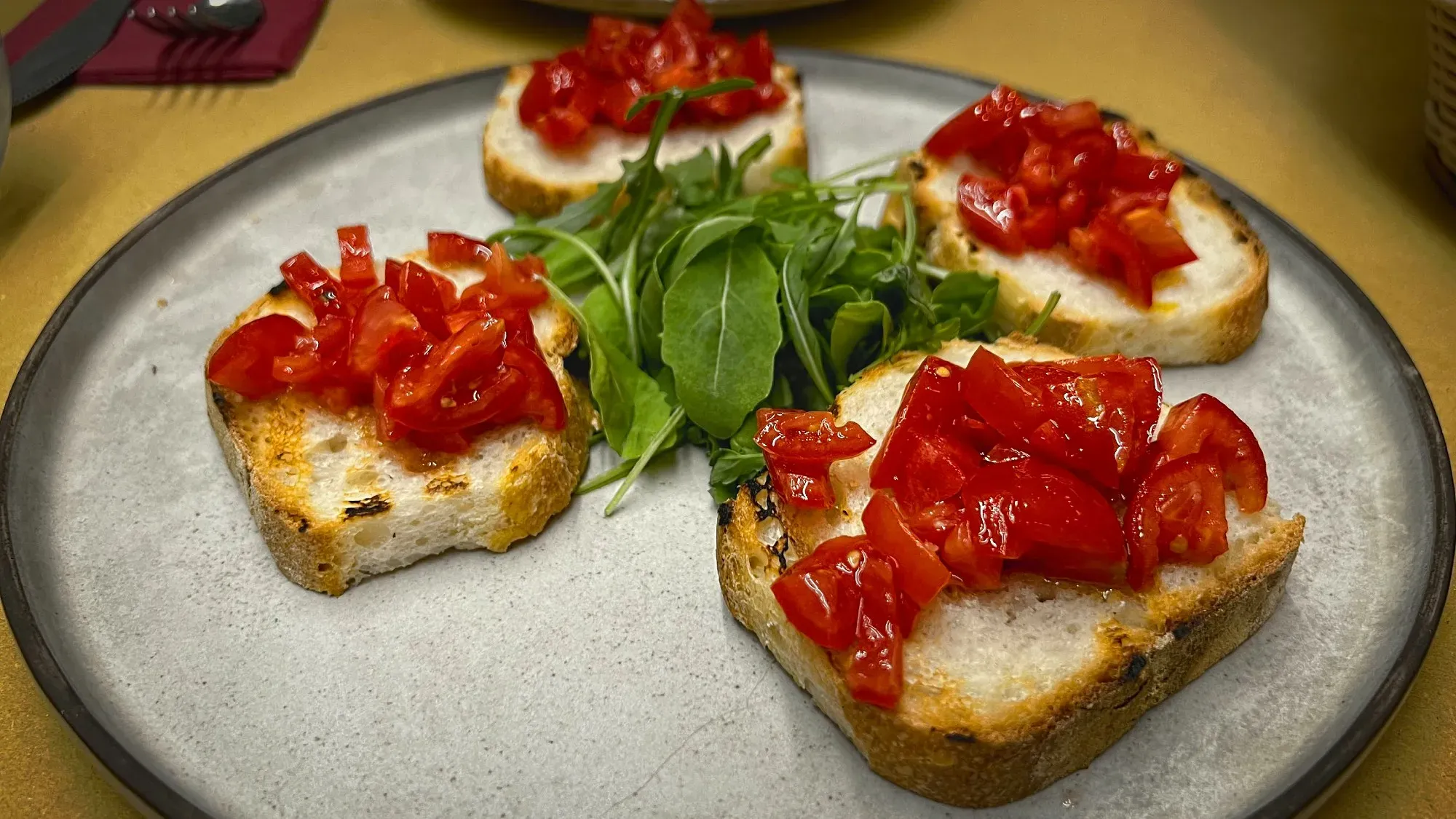
Bruschetta is a popular Italian appetizer of grilled, sourdough bread which is rubbed with garlic and topped with olive oil, salt, and tomatoes (commonly with oregano and basil as well). Bruschetta came about somewhere around the intersection of the Lazio and Toscana regions but is now a popular dish that can be ordered at practically any Italian restaurant. This simple yet delicious antipasto epitomizes Italian cuisine as it features many of the core Italian ingredients, and the key to its success is the quality of those ingredients.
Gelato
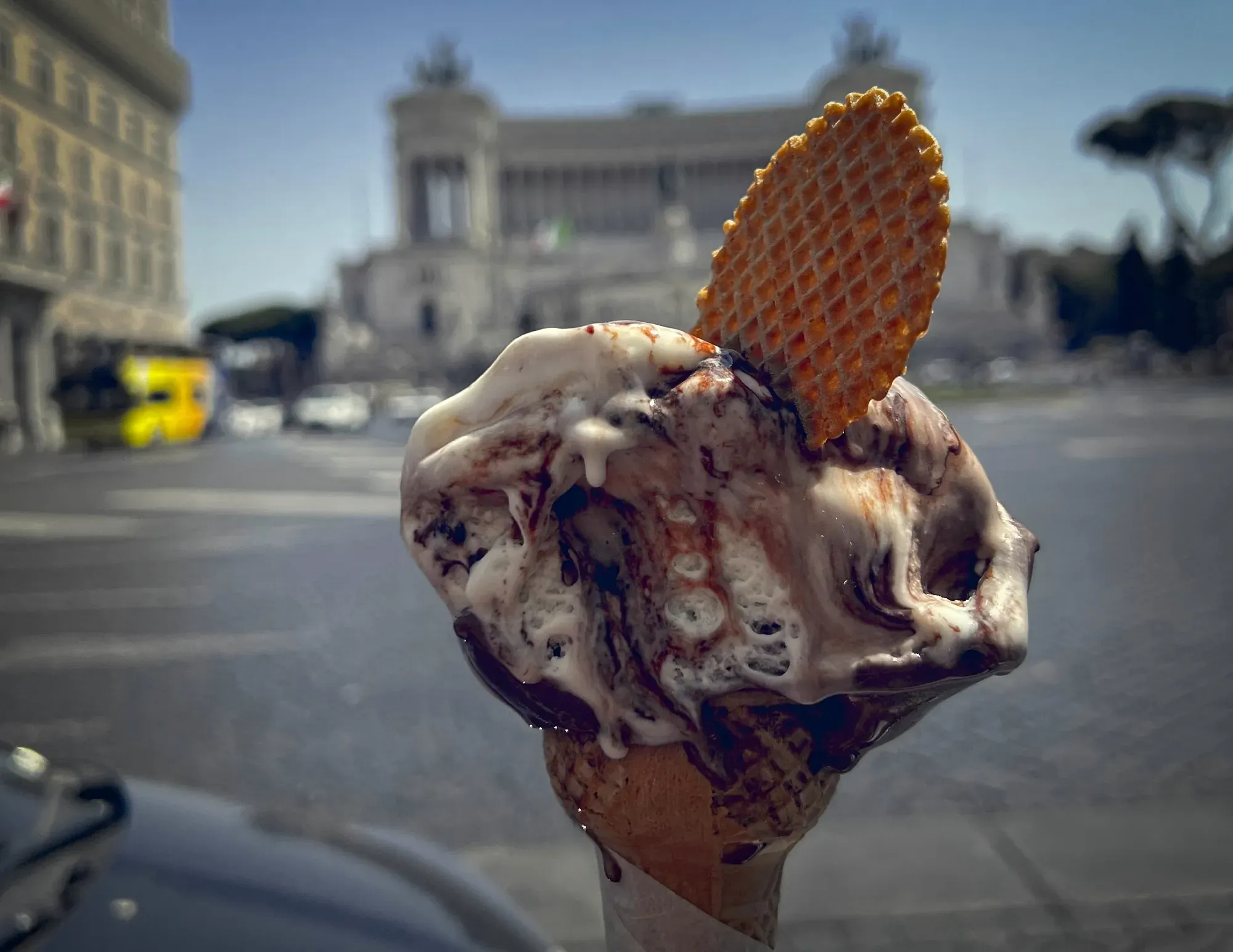
Gelato is the Italian version of ice cream. While similar, it is distinctly unique in its proportion of the ingredients and the process in which it is churned. Gelato and ice cream both use milk and cream, but the portion of whole milk to cream is much higher in gelato. Additionally, many modern ice creams include eggs, but gelato does not. Furthermore, Gelato is churned at a much slower rate than ice cream. This creates a much denser result as less air is incorporated into the mixture. A final note is the temperature. Gelato is able to achieve its signature soft and silky texture not only through this modified construction but by keeping the product at a slightly higher temperature.
Gelato first came about in the late 1500s when a man by the name of Bernardo Buontalenti tried to impress the King of Spain with his take on a creamy, frozen dessert. This display occurred at a Medici feast in Toscana (Tuscany), and so is covered here in the Central Italian region. Regardless of where you personally might stand on the ice cream vs. gelato vs. custard debate, when in Central Italy the Gelato is second to none.
Regional-Specific Shoutouts
Here we go through some of the region specific dishes that the average non-Italian person might not know about.
Carciofi alla Romana / Carciofi alla Giudia
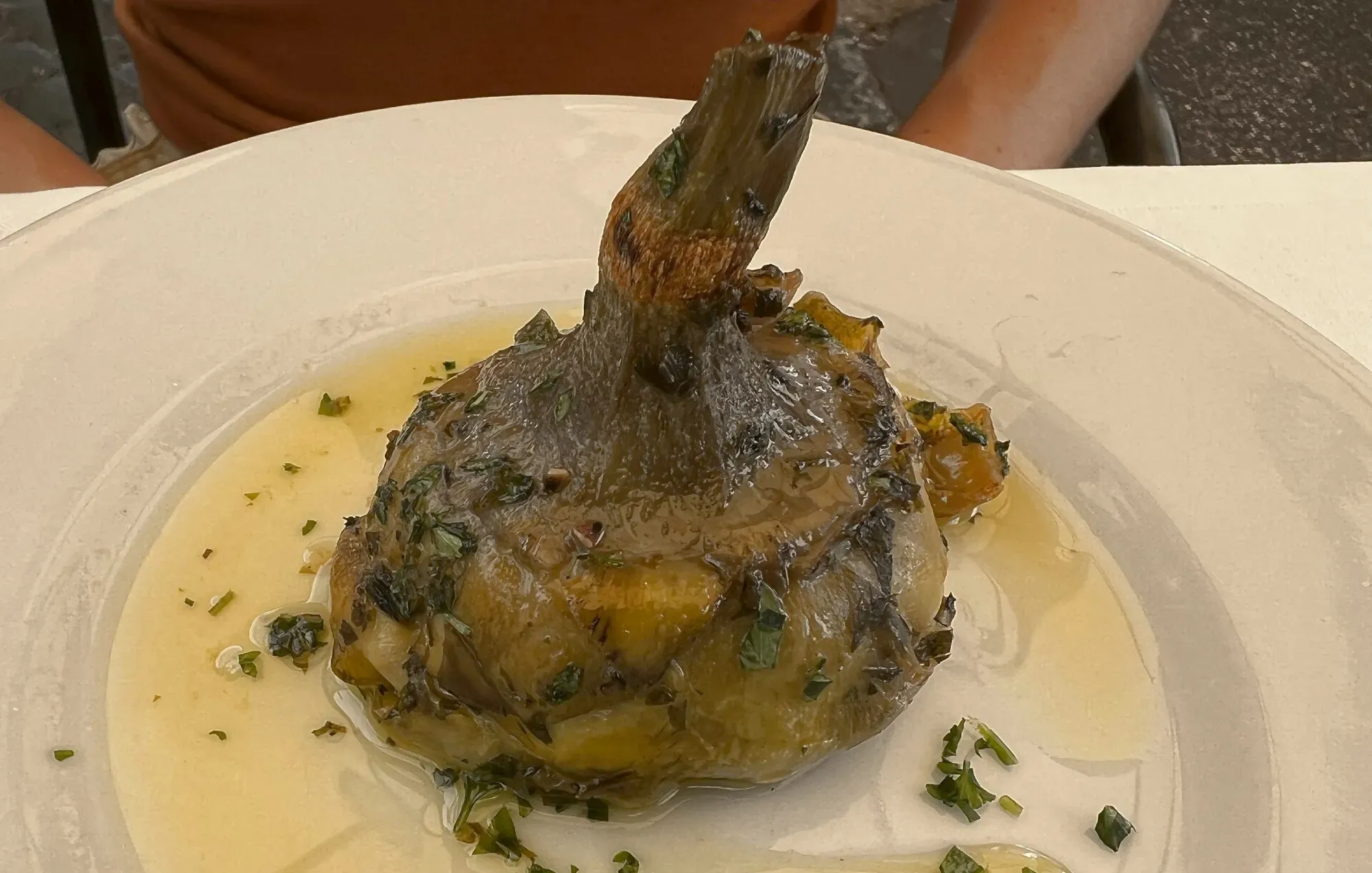
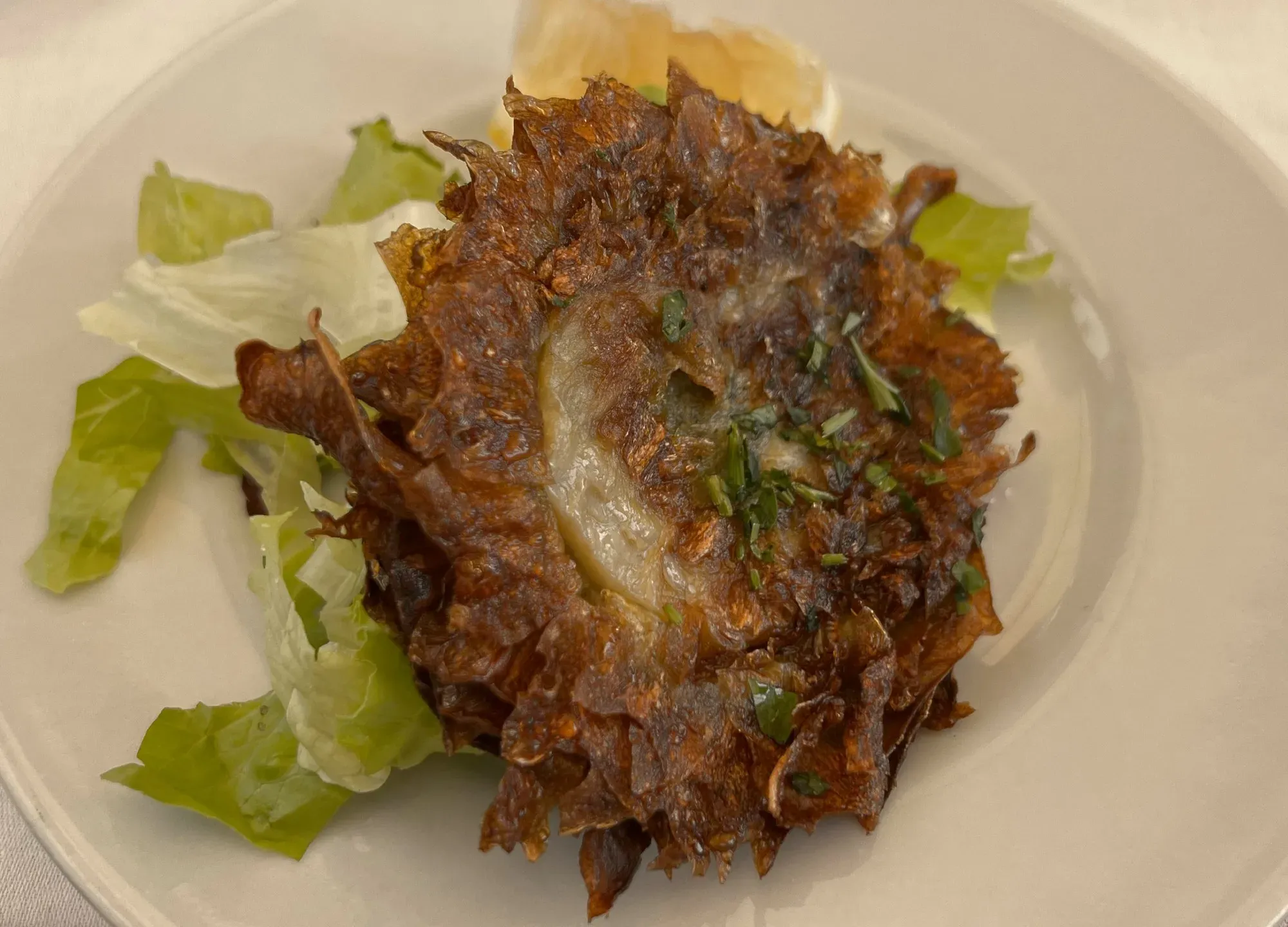
Artichokes grow well in the Lazio region around Rome and are loved by Italians in the region. In fact, the Roman artichoke (carciofo romanesco) is so unique that it now has gained I.G.P. status within Europe. Therefore, it should come as no surprise that Roman-style artichokes (Carciofi alla Romana) became a popular dish for the people of Rome. The dish is created by stuffing a Roman artichoke with garlic and mint and slow cooking in oil until it becomes tender.
Interestingly, another variety of this dish arose from the Jewish community in Rome. In 1555 the Roman government decreed that Jews in Rome must all be confined to a ghetto area in the south of the central city just above the Tiber River. This community seasoned the artichokes in lemon juice and then deep fried them to produce what we now call Carciofi alla Giudia (Note, the spelling on Guidia might be varied depending on which dialect you are reading). Both styles are delicious in their own way, and I would suggest ordering both when in Rome!
Trippa alla Romana
Trippa alla Romana is a traditional dish made from tripe that was once common "peasant food". Today, it is a common staple of Roman cuisine.
Supplì
Supplì is a popular street food in Rome. It is similar to the arancini from Sicily.
Trapizzino
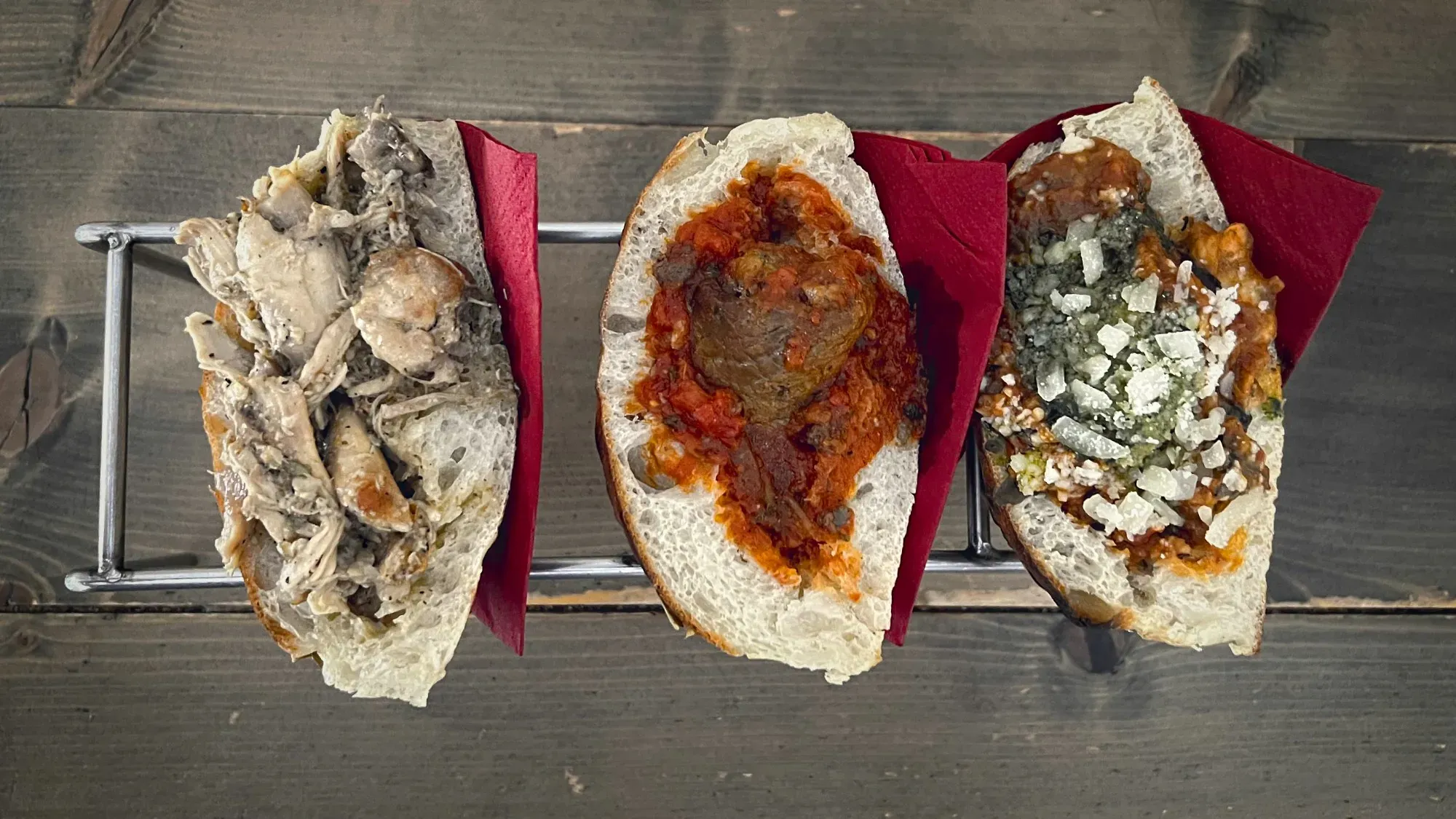
A modern invention, the trapizzino is a triangular pizza-pocket sandwich that takes the deliciousness of pizza and folds it into an easy-to-hold street food. While invented in Rome, it is now popular throughout Italy. Make sure you snag one while walking around; they are delicious.
Porchetta
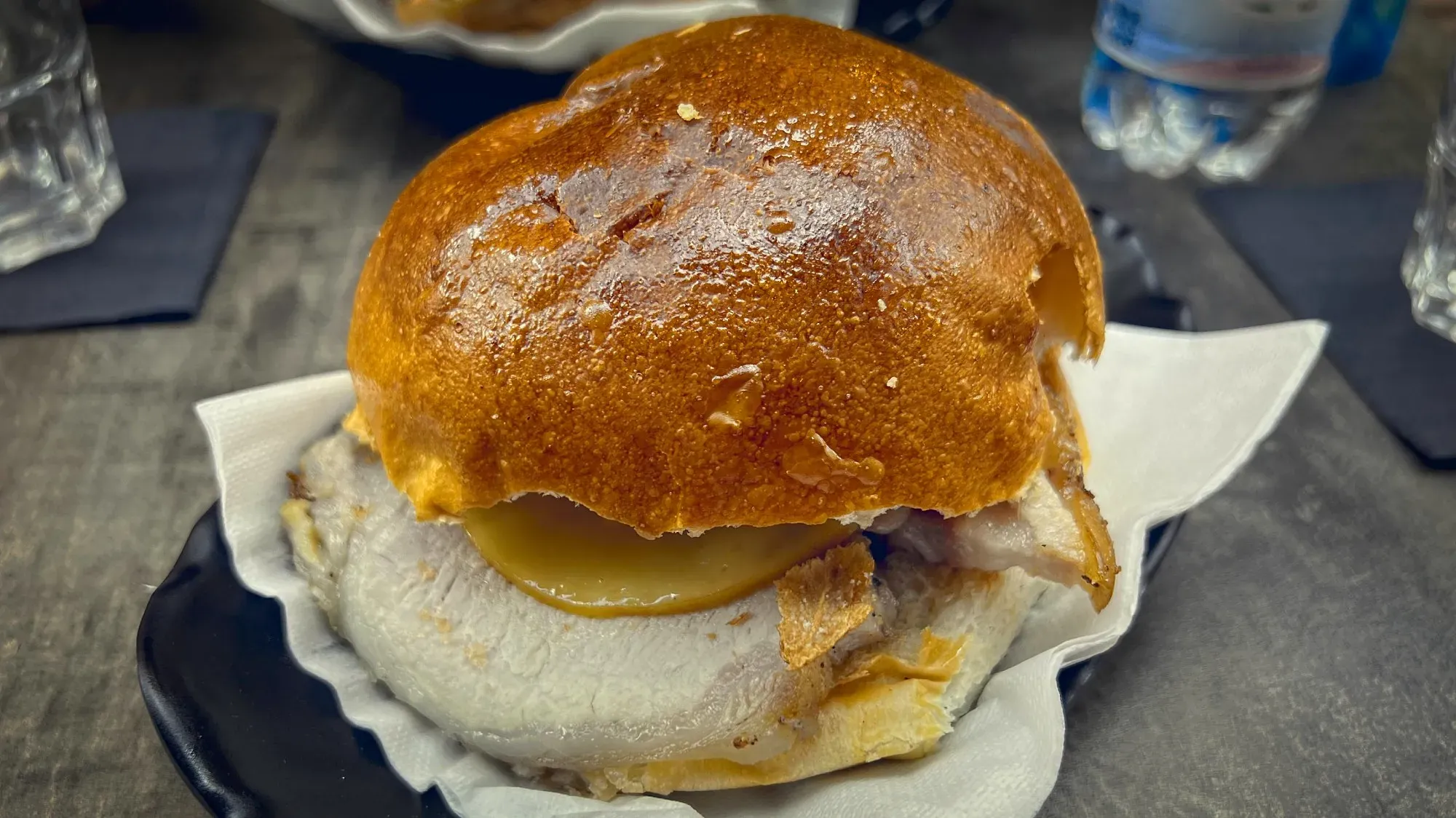
Porchetta is a slow-roasted, pork butt sandwich that is traditionally served with no other condiments. The preparation of the meat leaves a crispy exterior and a moist, aromatic interior but the lack of any other ingredient still left me desiring more flavorful sandwiches.
Maritozzi
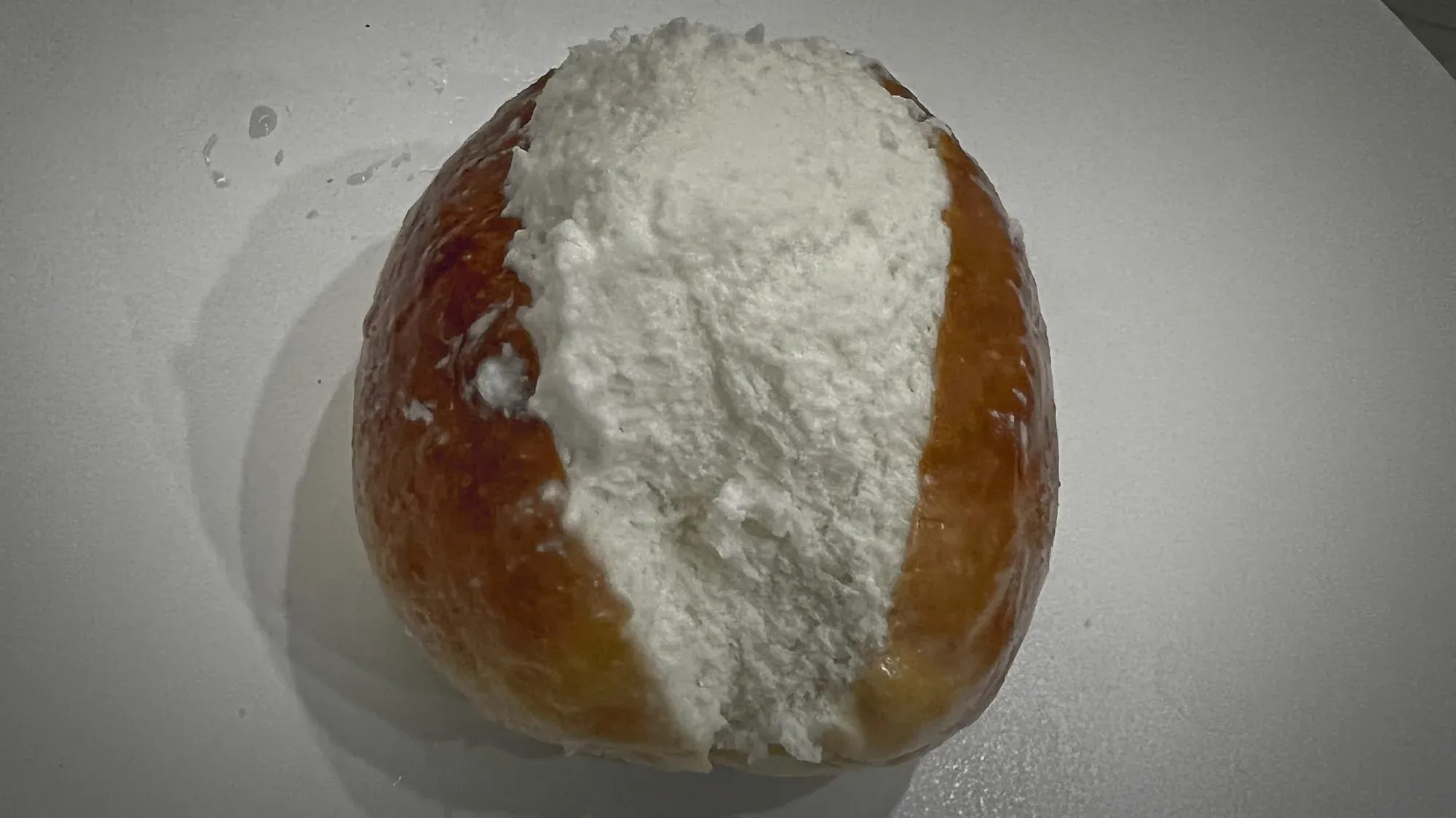
Maritozzi is an Italian sweet cream bun from the Lazio region. Historically, these treats were the only sweet that was allowed to be eaten during Lent, and so became an integral part of Roman cuisine. Maritozzi takes a light, brioche-style bun and fills it with sweet vanilla cream. Yum!
Polpette alla Romana al Sugo
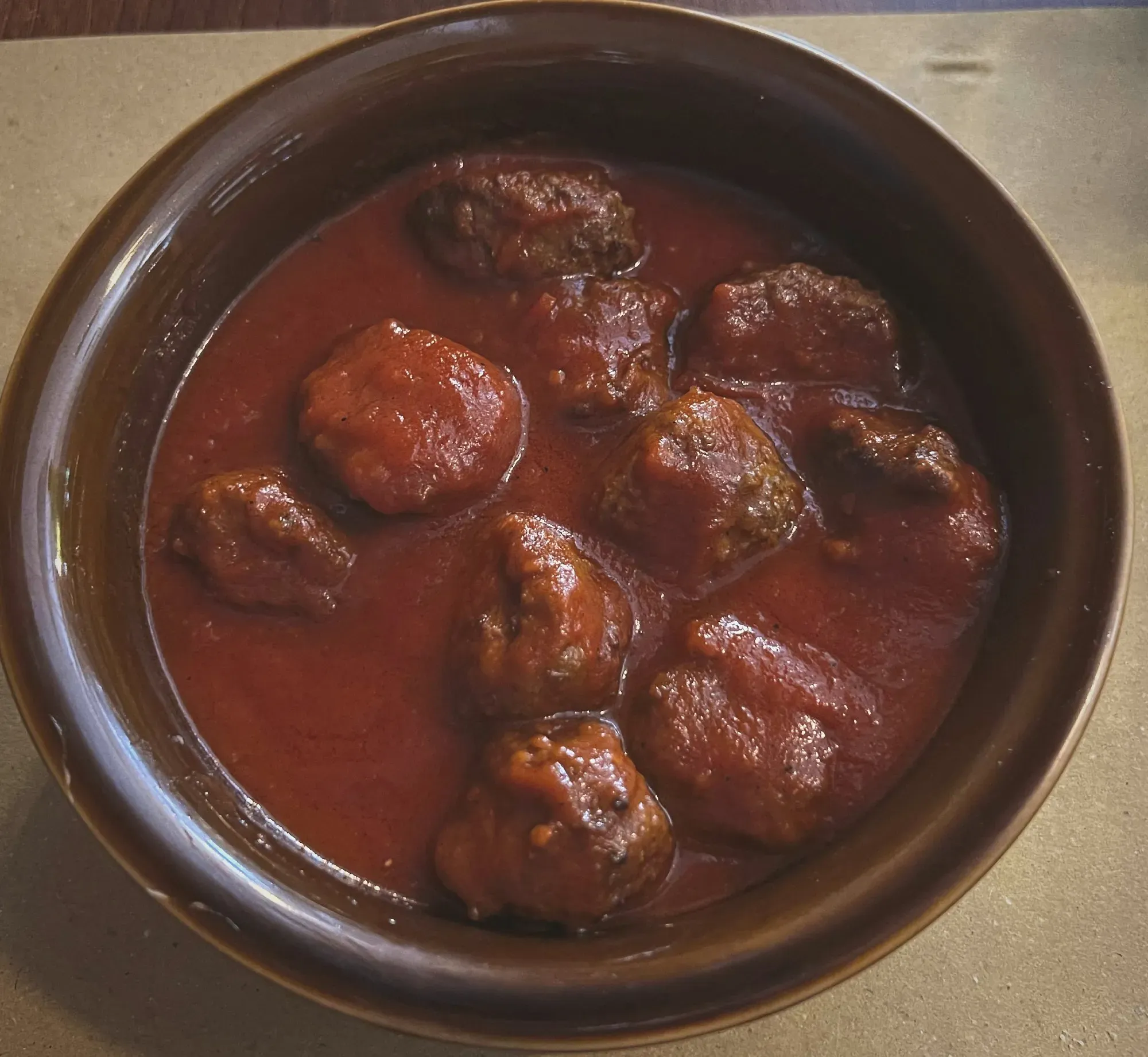
Al Sugo means "in sauce". Polpette means "meatballs". This dish is basically just meatballs in sauce. I mention this dish for two reasons: one, it is simple, yet delicious in Rome; two, it brings up that internet "myth" that spaghetti and meatballs are American, not Italian. It is not really a myth because it is technically correct, but it is a little disingenuous. Italians obviously invented spaghetti and tomato sauces, and have had meatballs as a part of their cuisine since before America existed. However, as we discussed above, Italians eat their pasta dish first (primi), and then their meat dish after (secondi)- two separate meals. Italian Americans changed the cuisine like Americans have done with all cuisines (you know, the great melting pot), by simply eating primi and secondi at the same time. Additionally, in America, they had access to larger quantities of meat at better prices so the meatballs you might think of on Spaghetti and Meatballs will be much larger than their Italian counterparts. So now you can clear up any meatball misconceptions, and are ready to find some delicious Polpette alla Romana al Sugo sometime in Italy.
Crostini Toscani
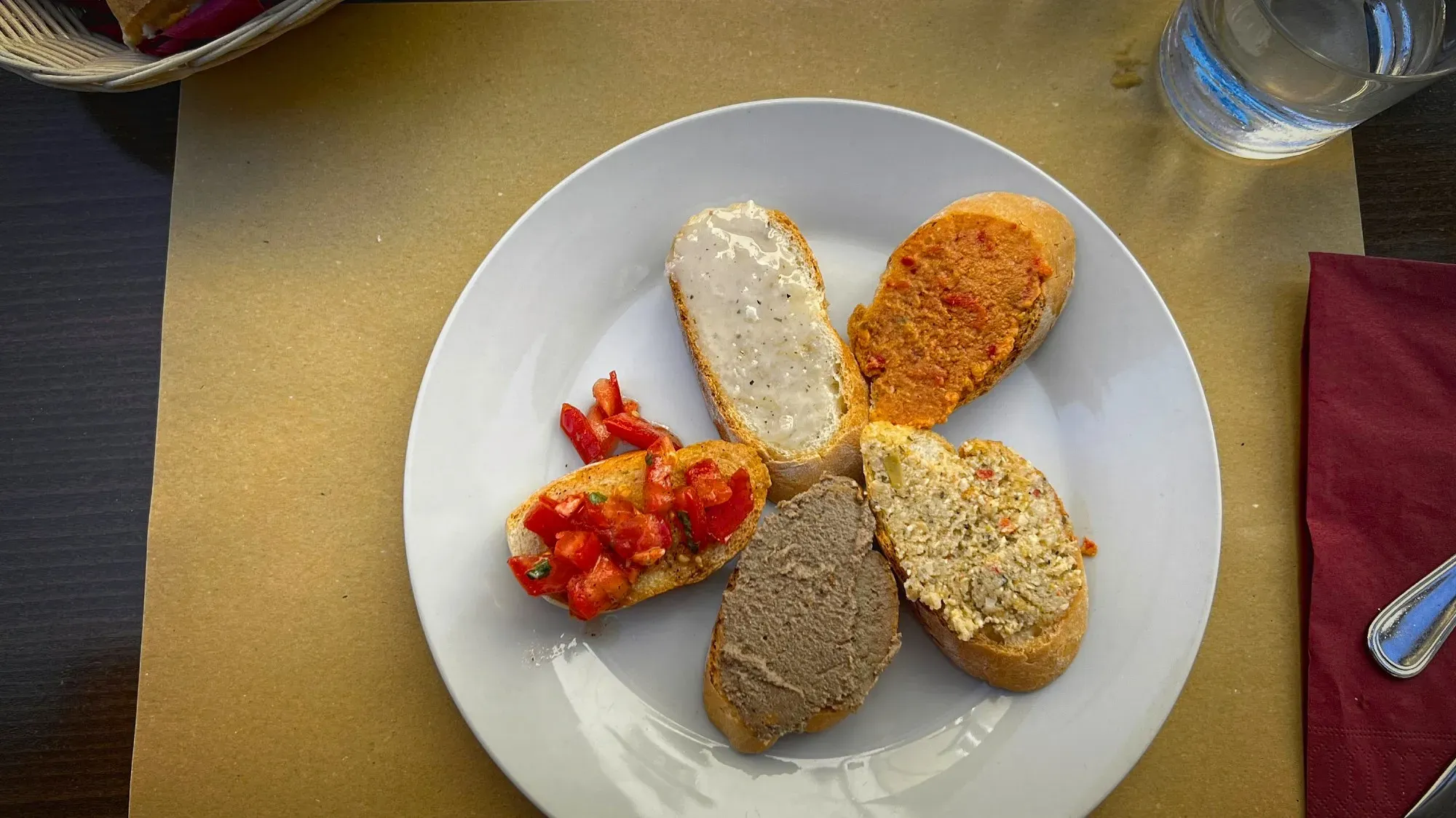
Crostini is a popular appetizer from Italy of small pieces of toasted bread with a topping. It is similar to Bruschetta but differs in that it is a white baguette bread that is toasted to a crisp instead of grilled. The modern culinary theme applies here though, in that many modern restaurants do not make such a large distinction here anymore and might use crostini and bruschetta interchangeably. Crostini Toscani refers to crostini with toppings that are popular in the Toscana (Tuscany) region: creamy chicken liver pâté; butter anchovies, and capers; caramelized onions and chilies; porcini mushrooms (from Umbria) and cheese.
Roman-Style Pizza
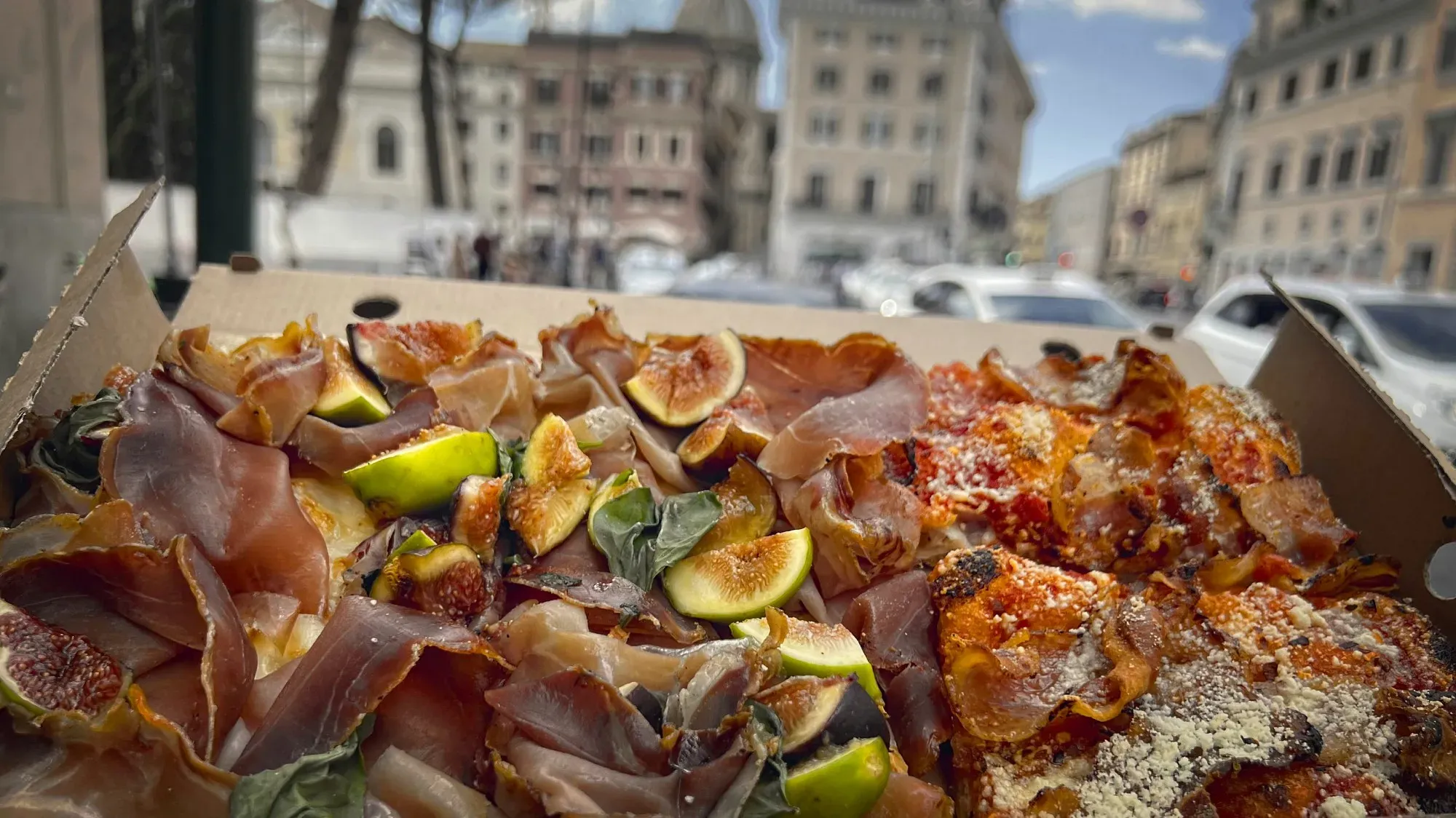
Pizza was covered as an entity in the Southern Italy Gastronomy post and is referenced here briefly as a comparison. Many cities across the world have their own take on pizza, stretching all the way from the traditional Neapolitan to the Chicago deep-dish. Roman pizza is a thin crust pizza, resembling more of a focaccia than most modern tomato-sauced pizzas. This "thin crust" can take a variety of forms- from a classic thin, crisp crust on an otherwise normal-looking pizza, to plentifully topped focaccia as seen in the picture above. Whatever your preferred style of pizza may be, make sure to give the local style a try when in Rome.
List of Other Things to Try:
- Bistecca alla Fiorentina (Famous large cuts of steak from cows in the region surrounding Firenze / Florence)
- Crostata Ricotta e Visciole (Sweet pastry tart with ricotta and sour cherries from Rome)
- Coda alla Vaccinara (Oxtail Stew from Rome)
- Abbacchio allo Scottadito ("Finger-burning" lamb chops from Rome)
- Filetti di baccalà fritti (Fried cod fillets from Rome)
- Pajata (Young calf intestines from Rome)
- Gnocchi alla Romana (Roman style Gnocchi - Different from what the rest of Italy defines Gnocchi, this is made of Semolina flour and baked)
- Lampredotto sandwich (Cow stomach sandwich from Firenze / Florence)
- Pappardelle al ragu di cinghiale (Wild boar pasta dish from Toscana / Tuscany)
- Panzanella (Bread salad from Toscana / Tuscany or Umbria)
- Ribollita (White bean bread soup from Toscana / Tuscany)
- Pappa al pomodoro (Tomato bread soup from Toscana / Tuscany)
- Cacciucco (Fish stew from coastal Toscana / Tuscany)
- Fagioli con salsiccia (Sausage and beans from Toscana / Tuscany)
For more information on where to go and places to see when traveling to any of these regions, check out our guide on visiting Southern Italy:
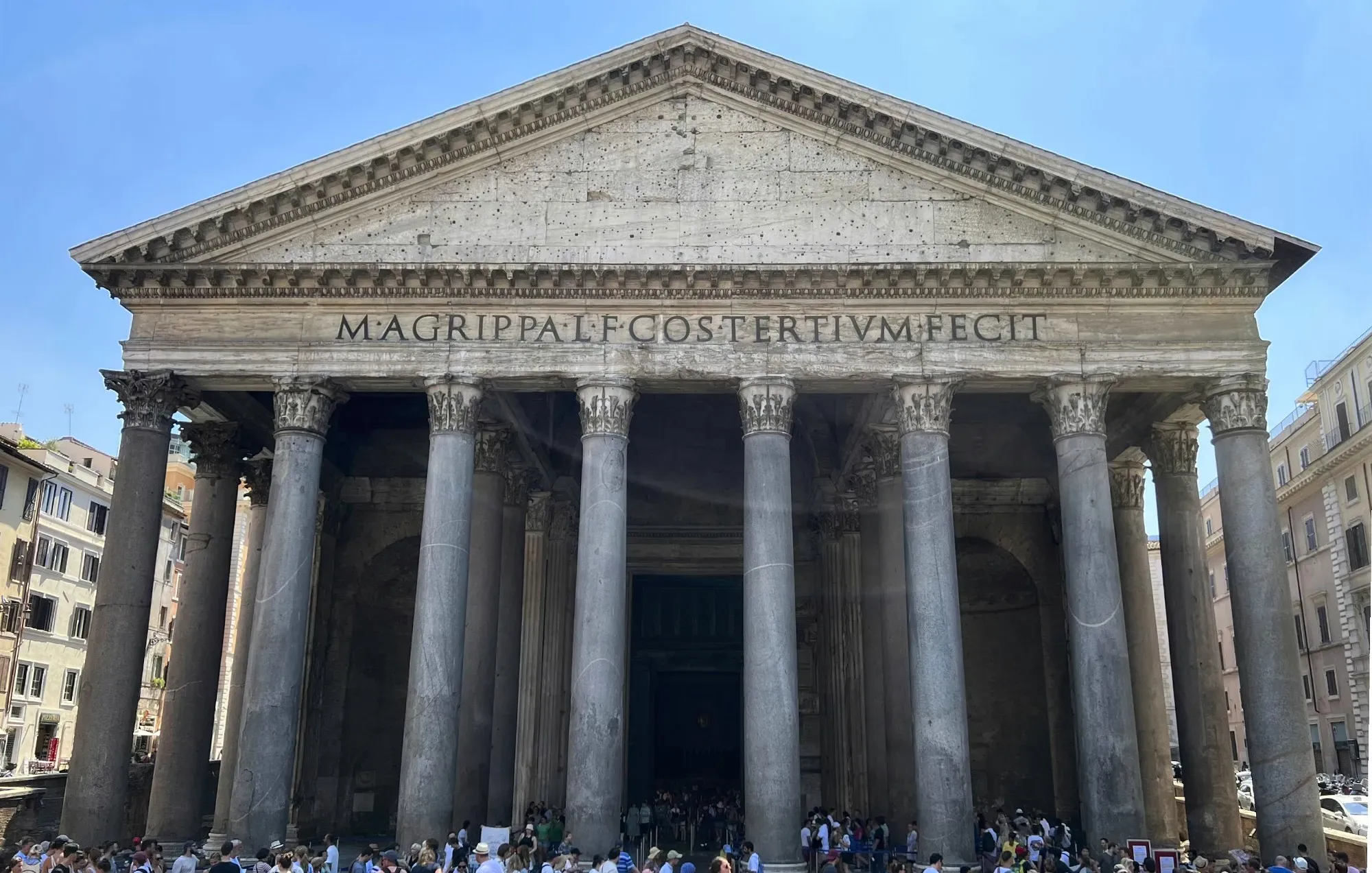
Resources
Restaurant Recommendations
When in Rome, you will want to find a few local pasta spots to get the Roman Four. Don't worry though, almost every restaurant in the city will be making one if not all of them. There are probably countless satisfactory pasta makers in Rome, but a guaranteed good time can be had at Da Enzo al 29. This restaurant used to be a local secret in Trastevere but has become a popular spot for foodie tourists who know how to use the internet. Even though the secret is out, it is still a delectable place to get the classic Roman pasta dishes.
Rome contains a local chain called Bona that makes fresh, great Roman flatbread-style pizza. It is affordable and surprisingly good for a mass-produced pizza shop so popular with tourists. This is absolutely a tourist thing but I would recommend it regardless.
One of my favorite restaurants in Rome was a cute Osteria tucked away in an alleyway called Poldo e Gianna. This restaurant is fancy enough to warrant its white-table cloth decor but is also affordable enough to be enjoyed on any budget. Serving both families and business clientele, Poldo e Gianna cooks up some incredible dishes all across the board that will make anyone a satisfied customer. Highly recommended.
Florence has a local gelato chain called La Strega Nocciola. I have eaten at over 50 gelaterias from all over Italy, and this one stands out as especially delicious. They make one of the most incredible Nocciola ("hazelnut") flavors I have ever had, and they have a phenomenal gelato called Bignolosa, which is a vanilla-based gelato with Nutella and cream puffs. Combining these two flavors, divine.
To see an extensive list of restaurant recommendations in Central Italy, check out the Food page to see a map of our top recommendations for Europe as well as the database with details on restaurants from all around the world.








